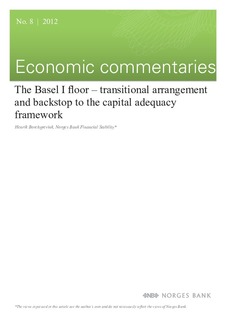| dc.description.abstract | Capital requirements are intended to ensure that banks have a certain amount of capital to absorb unexpected losses. These requirements take into account the riskiness of banks’ various loan exposures. Such risk weighting implies higher capital requirements for riskier exposures, e.g. small business loans, than for safer loans such as residential mortgages with a low loan-to-value ratio. Under the current framework for banking regulation, Basel II, banks have the option of internally calculating risk weights for their loan exposures. The risk weights are calculated using risk models that must be approved by the supervisory authorities before the banks can apply them. The former framework, Basel I, had a fixed set of risk weights that banks had to use. Basel II also defines a set of standardised risk weights that banks use when they do not calculate risk weights internally. When banks calculate their own risk weights, the capital requirements can become more risk-sensitive and more consistent with banks’ risk management practices and risk pricing. Banks can attain lower capital requirements measured in NOK by calculating risk weights internally. Basel II was introduced in the European Economic Area (EEA) in 2007. To prevent banks' internal risk weights from reducing risk-weighted assets and thus banks' capital needs too much and too quickly, temporary, lower limits were set for how much capital could be reduced. These limits were set relative to the previous framework, Basel I, which had a fixed set of risk weights. These limits are referred to as the "Basel I floors", or Basel II transitional arrangements, and in this Commentary are hereinafter referred as "the floor". In 2007, the floor was 95 percent of the Basel I requirement. In 2008, the floor was 90 percent and 80 percent in 2009. Although the floor was originally intended to expire at the end of 2009, a floor of 80 percent was retained and continues to apply in Norway and most EU countries. In a press release dated 13 July 2009, the Basel Committee announced that it had agreed to keep the floor in place beyond the end of 2009 without mentioning when it should expire. Applying the floor has become more complicated than necessary because it was not uniformly implemented in the EEA. In the Basel Committee's original proposal, the floor is, in reality, a floor for calculating risk-weighted assets. The EU legislation that implemented Basel II in the EEA defined the floor as a minimum level of capital. The two versions do not always produce the same result. This Commentary first looks at how differing interpretations of the floor result in country-to-country differences in capital requirements for banks. This is followed by a discussion of alternative backstop mechanisms that have been proposed in connection with the new Basel III framework which is being phased in from 2013 to 2019. | nb_NO |

